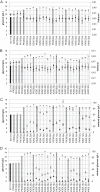Reduction of ethanol yield and improvement of glycerol formation by adaptive evolution of the wine yeast Saccharomyces cerevisiae under hyperosmotic conditions
- PMID: 24532067
- PMCID: PMC3993162
- DOI: 10.1128/AEM.03710-13
Reduction of ethanol yield and improvement of glycerol formation by adaptive evolution of the wine yeast Saccharomyces cerevisiae under hyperosmotic conditions
Abstract
There is a strong demand from the wine industry for methodologies to reduce the alcohol content of wine without compromising wine's sensory characteristics. We assessed the potential of adaptive laboratory evolution strategies under hyperosmotic stress for generation of Saccharomyces cerevisiae wine yeast strains with enhanced glycerol and reduced ethanol yields. Experimental evolution on KCl resulted, after 200 generations, in strains that had higher glycerol and lower ethanol production than the ancestral strain. This major metabolic shift was accompanied by reduced fermentative capacities, suggesting a trade-off between high glycerol production and fermentation rate. Several evolved strains retaining good fermentation performance were selected. These strains produced more succinate and 2,3-butanediol than the ancestral strain and did not accumulate undesirable organoleptic compounds, such as acetate, acetaldehyde, or acetoin. They survived better under osmotic stress and glucose starvation conditions than the ancestral strain, suggesting that the forces that drove the redirection of carbon fluxes involved a combination of osmotic and salt stresses and carbon limitation. To further decrease the ethanol yield, a breeding strategy was used, generating intrastrain hybrids that produced more glycerol than the evolved strain. Pilot-scale fermentation on Syrah using evolved and hybrid strains produced wine with 0.6% (vol/vol) and 1.3% (vol/vol) less ethanol, more glycerol and 2,3-butanediol, and less acetate than the ancestral strain. This work demonstrates that the combination of adaptive evolution and breeding is a valuable alternative to rational design for remodeling the yeast metabolic network.
Figures





Similar articles
-
Evaluation of gene modification strategies for the development of low-alcohol-wine yeasts.Appl Environ Microbiol. 2012 Sep;78(17):6068-77. doi: 10.1128/AEM.01279-12. Epub 2012 Jun 22. Appl Environ Microbiol. 2012. PMID: 22729542 Free PMC article.
-
Engineering of 2,3-butanediol dehydrogenase to reduce acetoin formation by glycerol-overproducing, low-alcohol Saccharomyces cerevisiae.Appl Environ Microbiol. 2009 May;75(10):3196-205. doi: 10.1128/AEM.02157-08. Epub 2009 Mar 27. Appl Environ Microbiol. 2009. PMID: 19329666 Free PMC article.
-
Effects of GPD1 overexpression in Saccharomyces cerevisiae commercial wine yeast strains lacking ALD6 genes.Appl Environ Microbiol. 2006 Jul;72(7):4688-94. doi: 10.1128/AEM.02975-05. Appl Environ Microbiol. 2006. PMID: 16820460 Free PMC article.
-
Yeast's balancing act between ethanol and glycerol production in low-alcohol wines.Microb Biotechnol. 2017 Mar;10(2):264-278. doi: 10.1111/1751-7915.12488. Epub 2017 Jan 13. Microb Biotechnol. 2017. PMID: 28083938 Free PMC article. Review.
-
Flor yeasts of Saccharomyces cerevisiae--their ecology, genetics and metabolism.Int J Food Microbiol. 2013 Oct 15;167(2):269-75. doi: 10.1016/j.ijfoodmicro.2013.08.021. Epub 2013 Sep 10. Int J Food Microbiol. 2013. PMID: 24141073 Review.
Cited by
-
Biomodulation of Physicochemical Parameters, Aromas, and Sensory Profile of Craft Beers by Using Non-Saccharomyces Yeasts.ACS Omega. 2022 May 16;7(21):17822-17840. doi: 10.1021/acsomega.2c01035. eCollection 2022 May 31. ACS Omega. 2022. PMID: 35664572 Free PMC article.
-
Dual-temperature dual-state fermentation: A novel approach to improve aroma and color characteristics of Marselan wines.Food Chem X. 2025 Apr 9;27:102447. doi: 10.1016/j.fochx.2025.102447. eCollection 2025 Apr. Food Chem X. 2025. PMID: 40270646 Free PMC article.
-
Activation of the yeast Retrograde Response pathway by adaptive laboratory evolution with S-(2-aminoethyl)-L-cysteine reduces ethanol and increases glycerol during winemaking.Microb Cell Fact. 2024 Aug 20;23(1):231. doi: 10.1186/s12934-024-02504-z. Microb Cell Fact. 2024. PMID: 39164751 Free PMC article.
-
Specific Phenotypic Traits of Starmerella bacillaris Related to Nitrogen Source Consumption and Central Carbon Metabolite Production during Wine Fermentation.Appl Environ Microbiol. 2018 Aug 1;84(16):e00797-18. doi: 10.1128/AEM.00797-18. Print 2018 Aug 15. Appl Environ Microbiol. 2018. PMID: 29858207 Free PMC article.
-
Effects of Different Yeasts on Physicochemical and Oenological Properties of Red Dragon Fruit Wine Fermented with Saccharomyces cerevisiae, Torulaspora delbrueckii and Lachancea thermotolerans.Microorganisms. 2020 Feb 25;8(3):315. doi: 10.3390/microorganisms8030315. Microorganisms. 2020. PMID: 32106517 Free PMC article.
References
-
- Buescher WA, Siler CE, Morris JR, Threlfall RT, Main GL, Cone GC. 2001. High alcohol wine production from grape juice concentrates. Am. J. Enol. Vitic. 52:345–351
-
- Novello V, De Palma L. 2013. Viticultural strategy to reduce alcohol levels in wine, p 3–8. In Vigne et Vin Publications Internationales (ed), Alcohol level reduction in wine. Proceedings of the 1st Oenoviti International Symposium, Bordeaux, France
-
- Aguera E, Bes M, Roy A, Camarasa C, Sablayrolles J-M 2010. Partial removal of ethanol during fermentation to obtain reduced-alcohol wines. Am. J. Enol. Vitic. 61:53–60
Publication types
MeSH terms
Substances
LinkOut - more resources
Full Text Sources
Other Literature Sources
Molecular Biology Databases

